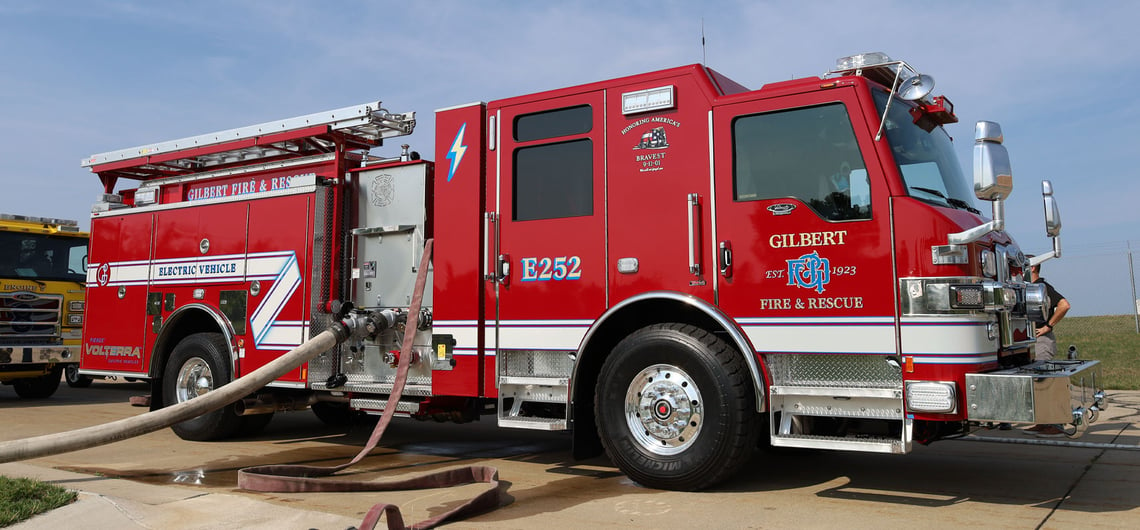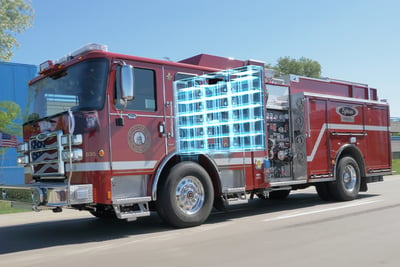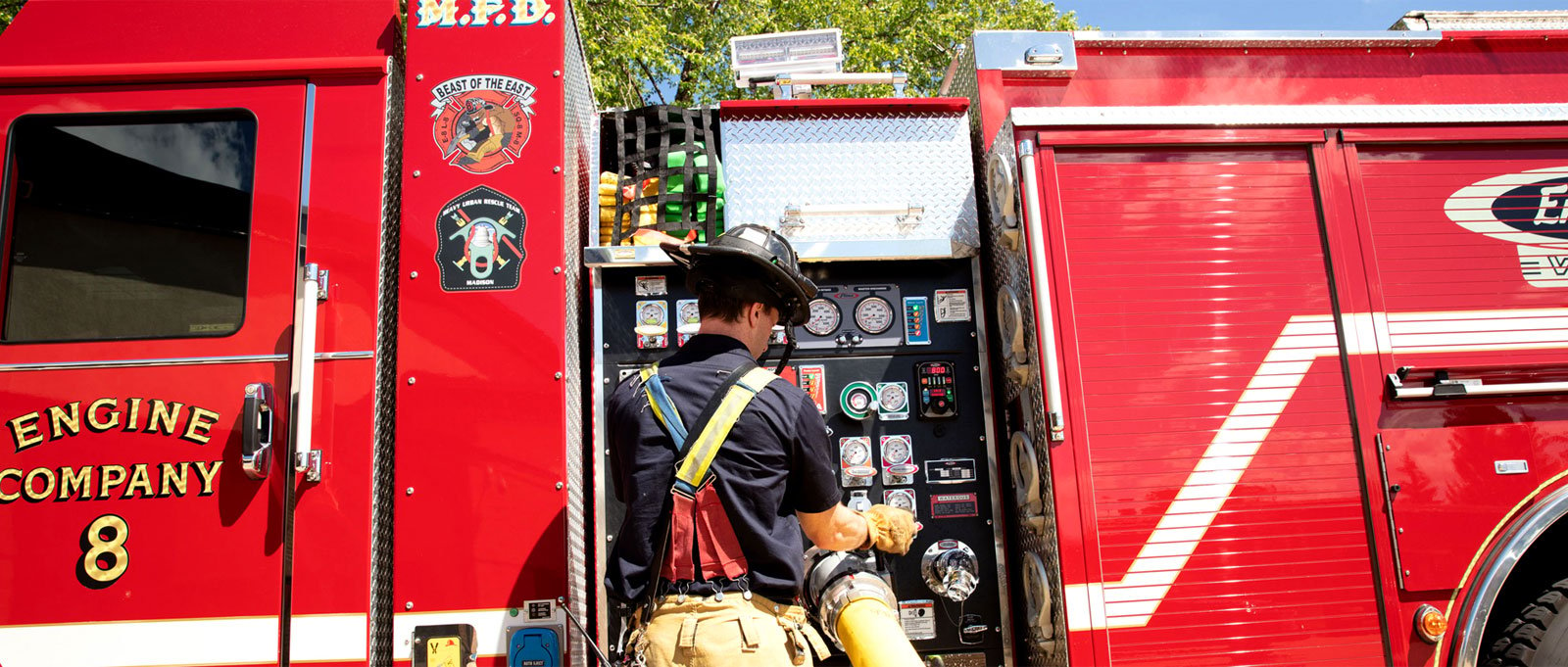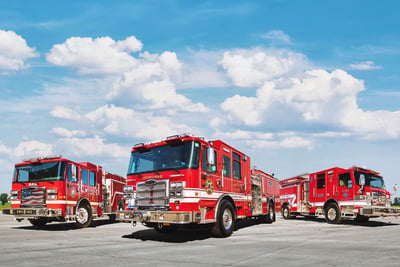 As the demand for electric fire trucks increases, there continue to be questions about performance and comparisons to traditional trucks.
As the demand for electric fire trucks increases, there continue to be questions about performance and comparisons to traditional trucks.
Pierce Manufacturing sat down with the engineering team to talk through some of the most common questions and potential misconceptions they've encountered, and we have outlined that discussion in this Electric Fire Truck Q+A series.
Question: What is the difference between a parallel-electric drivetrain and a range-extended series-electric drivetrain?
Answer: There are significant differences; most importantly, how the back-up power system is coupled to the drivetrain.
There are two common approaches to electric drivetrains in fire apparatus today: one is a parallel arrangement the other is a series arrangement. A significant difference between the design architecture is how the batteries are used (or not used) once the battery levels are depleted.
Pumping on Battery Series Arrangement

The batteries in a range-extended series-electric arrangement are coupled to the drivetrain, but once the batteries become depleted, the back-up power source may not be able to supply enough power to manage pump operations.
A range-extended series-electric drivetrain vehicle runs on battery power and utilizes a generator or engine as back-up power. Once the batteries’ state of charge drops below a specified threshold, the range extender begins to charge the batteries while the batteries continue to power all operations.
A parallel-electric drivetrain fire truck can power vehicle functions independently of the batteries. In contrast, a range-extended series-electric vehicle often relies on the batteries at all times, and the range-extending charging system is usually not sized to directly power the fire truck. Battery failure can severely limit the operation of the fire truck.
Pumping on Battery Parallel Arrangement

With the engine coupled directly to the drive line, a fire apparatus with a parallel-electric drivetrain is able to switch from all-electric mode to all-engine mode, bypassing the batteries completely. Power is never diminished in a parallel-electric drivetrain fire truck because each system operates independently and each is sized to meet the rated capacity requirements.
Parallel-electric drivetrain fire apparatus operate in either all-electric mode or internal combustion engine mode. In other words, the fire truck operates under electric power in normal situations and uses an internal combustion engine (ICE) for back-up power during prolonged emergency operations. With the engine coupled directly to the drive line, the fire apparatus is able to switch from all-electric to all-engine mode, bypassing the batteries completely. This distinction can be important when a fire engine is tasked with managing a prolonged fire event.
Question: Can an electrified fire engine manage a long fire event?
Answer: It can, it just depends on the type of electrified vehicle and how the drivetrain architecture is designed.
Different types of electrified fire trucks manage long fire events differently depending, in part, on the type of vehicle and the architecture of the drivetrain. Fire departments may have concerns about losing performance capacity as the batteries on an electrified fire engine deplete when running in electrification mode.
Next, we will discuss how the two main types of electrified fire trucks attempt to address this concern.
 Parallel-electric Drivetrain Fire Apparatus
Parallel-electric Drivetrain Fire Apparatus
A fire apparatus having a parallel-electric drivetrain, like the Pierce Volterra truck, is designed to be used in either an all-electric mode or an internal combustion mode. Regardless of the source of power, the vehicle is designed to both:
- Provide continuous and uninterrupted driving capability for ongoing emergency response and;
- Operate the pump at its rated capacity without having to reduce its ability to support the on-scene demands.
Power is plentiful in Pierce’s parallel-electric drivetrain fire truck because the electric drive system and the combustion drive system operate independently and are each sized to meet the rated capacity requirements of the truck.
The batteries on the Pierce Volterra truck are designed to power all truck operations as long as the battery level is running above the lowest threshold. Once below the threshold, the ICE automatically kicks in and maintains the rated power to the vehicle. Like the all-electric mode, the ICE mode is able to power all truck operations at full capacity, including the ability to drive the vehicle or pump up to 2000 gpm at a continuous rate of pressure and performance.
The Pierce Volterra’s engine is sized to support a 2000 gpm pump. Therefore, it can run continuously during extended duration events like a traditional apparatus even after the batteries are depleted.
Range-extended Series-Electric Drivetrain Fire Apparatus
In contrast to the Pierce Volterra trucks with a parallel-electric drivetrain, a range-extended series-electric drivetrain vehicle is designed to use battery power until the batteries are depleted and then uses an engine driven generator to continue to power truck operations through the battery.
In certain series-electric configurations, the batteries are involved in the vehicle’s ability to provide power, and once the batteries become depleted, or faulted, the back-up power source may not be able to supply enough power, through the batteries, to manage pump operations. This configuration may also limit resiliency as the range extender may not be able to make up for depleted battery power. Additionally, some electric fire truck systems may not be sized large enough to meet the power requirements of a 2000 gpm pump, let alone be adequate to first charge the batteries and then run the pump at the rated capacity.
When it comes to a large structure fire, reliance on a generator or engine to continuously power depleted batteries may force firefighters to consider changing their operational strategy and/or operate at a reduced pump capacity.

Question: Can an electrified fire truck be rendered unable to move, pump, or function completely if batteries are depleted or damaged?
Answer: Again, it depends on the type of electrified fire truck and how the drivetrain architecture is designed.
An apparatus with a range-extended series-electric drivetrain and back-up power supply may not be sized appropriately to function as needed with depleted or damaged batteries. However, a parallel-electric drivetrain fire engine will be able to fully function even with depleted or damaged batteries.
Here’s why.
Depleted Battery Operation
When a parallel-electric drivetrain fire truck’s batteries are depleted, the truck automatically switches to the independently-coupled ICE via a parallel drivetrain to power all operations. The system architecture facilitates using available engine power for pump operations. The pump is able to maintain consistent, full-power capabilities. The ICE is sized appropriately to complete all required truck operations, even if the truck needs to re-position or drive to a new location.
A range-extended series-electric vehicle with depleted batteries, on the other hand, may not be able to move as desired until the batteries are re-charged, and charging may not occur while pumping. This design architecture may thereby limit:
- The vehicle’s emergency readiness and;
- Its operational performance, until the batteries are recharged.
Damaged or Faulted Battery Operation
The parallel-electric drivetrain architecture on the Pierce Volterra truck offers another advantage over series-electric configurations: If a battery cell is damaged or if the battery has a fault, the ICE is sized and connected as a full-power solution to manage rated operations until the battery issue can be addressed.
A range-extended series-electric drivetrain may have to stop operation, operate with restricted performance capabilities, etc., until the battery issues can be addressed.
Fire departments rely on having mission-ready trucks available for use when needed. A depleted battery may render a truck unusable until charging is complete and may not be a reliable option for many fire departments.
 Pierce Volterra: A Distinct Difference
Pierce Volterra: A Distinct Difference
The Pierce Volterra electrified fire truck is designed to provide fire departments with an apparatus we believe provides the best of both worlds: an electrified solution with dependable and consistent power, performance and fire ground capabilities in all modes of operation.
Whether driving or pumping, the operational benefits of the Pierce Volterra parallel-electric drivetrain mean firefighters can have confidence when performance is critical.
Learn more about electrified fire trucks, the Volterra platform of electrified vehicles or contact your local dealer today to hear more about why our power solution makes a huge difference.